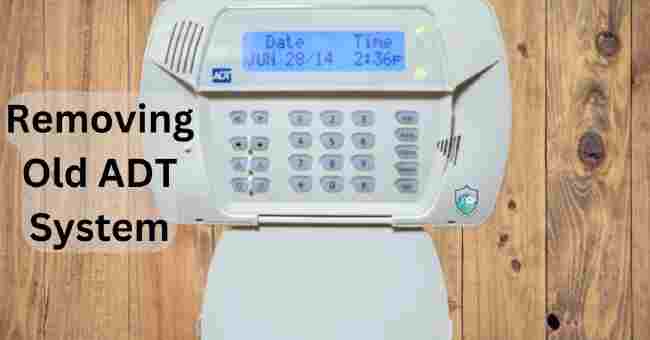Have you ever wondered, what is the simplest way for removing old ADT system? Yes, Upgrading to a newer system often makes sense to gain better features and technology.
But determining the right process to safely eliminate outdated equipment yourself or hire a professional can be challenging.
I faced this dilemma myself recently when moving to a new home. After years of paying for lackluster
monitoring and false alarms, I was fed up with my old ADT system.
I wanted to DIY remove everything to save money. However, I quickly realized risks like damaging walls or getting shocked.
Here’s the emotional journey I went through figuring out the smartest way forward. Let me explain the full removal process so you can avoid mistakes.
Are you considering removing an old ADT system from Home security? ADT systems can become outdated over time as technology improves.
You may want to upgrade to a new system with better features, or remove security altogether if it’s no longer needed.
Removing an ADT system yourself seems easy, but there are some important steps to follow.
Read on to learn the full process of safely and properly removing an old ADT security system.
Reasons for Removing Old ADT System
There are a few common reasons homeowners decide to remove their ADT security system:
- Upgrading to a new system – ADT systems can become outdated after 5-10 years. Newer systems have better technology with more features. You may want to upgrade to take advantage of improvements.
- Switching security companies – You may want to switch to another security provider that offers better pricing, equipment or monitoring services. This requires full removal of old ADT equipment.
- No longer needing security – If you’ve moved to a safer neighborhood or have other reasons security is no longer needed, you may decide to remove the old system entirely.
- Cost savings – Canceling ADT monitoring services and removing equipment can sometimes lower costs, especially if paid monthly. Weigh pros and cons first.
- Remodeling/renovations – A major remodel is a perfect time to remove the old system and potentially install an updated one after completion.
No matter the reason, properly removing an ADT system yourself is possible. But there are some guidelines to follow.
Dangers of Improperly Removing Old ADT System
It’s tempting to quickly tear out an old home security system yourself without considering the consequences.
But improperly removing ADT equipment can be dangerous and lead to problems down the road.
Potential risks include:
- Damaging walls or property if not careful detaching components
- Leaving behind wires that create unsafe conditions
- Failure to disconnect power sources resulting in shock risk
- Not following ADT guidelines and violating your contract
- Deactivating security monitoring before removal resulting in no protection
Doing a rushed DIY removal to save money may seem convenient in the short term. But the risks often outweigh the rewards. Following ADT’s recommended removal process is always the safest bet.
The ADT System Removal Process Explained
Removing an ADT security system properly involves several key steps. The general removal process includes:
1. Review Your ADT Contract
The first step is thoroughly reviewing your ADT customer contract. Checking the fine print will reveal any clauses about early termination fees or required procedures when canceling services.
Some key questions to have answered are:
- Is there a termination fee for removing service before the contract ends? Fees often range from $100-$400 or more.
- Are you required to have ADT technicians remove equipment vs. DIY removal? There may be penalties for DIY removal.
- How far in advance must removal or contract termination be requested? 30+ days is common.
- Will any equipment need to be returned after removal? Sensors often must be returned.
Knowing your contractual obligations will prevent headaches down the road. Don’t skip this step.
2. Disable and Power Down the System
Once you know the terms for removal, the next step is properly powering down components. This involves:
- Calling ADT monitoring center to disable alarm monitoring services for your home. It must be disabled before removal.
- Disconnecting the backup battery and AC power cord to fully cut power to the control panel.
- Powering down any other equipment like cameras or lighting systems.
The control panel must have no power during the removal process for safety. Fully power down the system before moving to the next steps.
3. Identify and Detach All System Components
Now comes the hands-on work of removing devices. An ADT system typically includes:
- Control panel (brain of the system)
- Keypad
- Motion sensors
- Door/window entry sensors
- Glass break sensors
- Smoke/heat/CO detectors
- Security cameras
- Alarm siren
- Yard signs and window stickers
Make a full list of all components in your system. Then begin detaching each from walls and other mounting points. Be gentle to avoid property damage.
Many sensors can simply be pulled off of walls or surfaces once the adhesive is loosened. Cameras, keypads and detectors will require gentle unscrewing from mounts. Take care not to break any parts in this step.
4. Remove and Disconnect Wiring
Leftover wiring is one of the biggest hazards if an ADT removal is incomplete. Thoroughly removing all wires involves:
- Locate the points where wiring enters walls from attics/crawl spaces.
- Cut wiring so no loose ends are left behind in walls or ceilings.
- Detach and remove any wiring connectors.
- Coil up all cut wiring and safely dispose or recycle.
Eliminating unused wiring simplifies future renovations or upgrades. It also prevents unsafe conditions. Take time to remove all old wiring during this stage.
5. Remove and Properly Dispose of the Control Panel
With all system components detached, it’s time to safely remove the ADT control panel itself:
- Remove any remaining screws or hardware anchoring it to the wall.
- Cut away any loose wiring still attached to the panel.
- Carefully detach it from the wall without allowing it to fall.
- Consider hiring an electrician if hardwired into the home’s electrical system.
- Consult your city’s guidelines for disposing of old electronics like control panels.
If any components need to be returned to ADT, set them aside for return shipping. Otherwise, safely dispose of all old equipment.
6. Patch and Repair Walls
With the security hardware removed, you’ll likely have holes, damaged drywall or other cosmetic issues. Use these tips for patching:
- Fill any screw holes with drywall compound. Allow to dry fully.
- Lightly sand any raised areas to smooth flush with walls.
- Spot paint repaired sections with matching interior paint.
- Paint entire walls if needed to blend patched areas.
Take time to carefully patch walls and paint so repairs are invisible. Remove any leftover debris or dust from the removal process as well.
7. Install a New System or Re-Evaluate Security
With the old system fully removed, it’s time to make your next security decision:
- Upgrade to a new system – Use the opportunity to install a modern security system with the latest technology and features. Get quotes from ADT or shop other providers.
- Go without security temporarily – If you plan to renovate soon, you may want to wait to install a new system later. But make sure your home insurance still covers theft/vandalism without a working security system in place.
- Eliminate security completely – If security is no longer needed for your situation, you can leave the house with no system after removal. Just be aware of the risks involved.
Carefully weigh your options before making your next security move after removing equipment. Don’t leave your home vulnerable for long periods without protection.
Mistakes to Avoid When Removing an ADT System
While the removal process itself is straightforward, it’s easy to make mistakes. Avoid these common errors to ensure safe, effective removal:
- Failing to fully power down the control panel before removal. Live electricity creates major shock risk.
- Attempting to remove hardwired components like smoke detectors without an electrician’s help.
- Leaving sensors, cameras or leftover wiring behind in walls after removal. Creates hazards.
- Tossing old batteries, control panels and electronics in the household trash. Items contain hazardous materials requiring special disposal.
- Skipping patching drywall holes or repairing other damage from removal. Creates added expenses later.
- Canceling monitoring too early before removal is complete. Results in no active alarm system for the home.
- Not reviewing your contract. DIY removal can violate ADT terms and result in fees.
Planning carefully and following best practices will help avoid major mistakes and ensure a smooth removal process. Never take shortcuts when removing security systems yourself.
FAQ About Removing Old ADT System
For additional guidance, here are answers to some frequently asked questions:
Does It Cost Anything to Have ADT Remove a System?
In most cases there is no fee for ADT technicians to remove equipment at your request after terminating monitoring services. But read your contract to confirm.
Can I Return ADT System Parts After Removal?
Sensors and other devices must typically be returned to ADT when service ends. Control panels can be disposed of or recycled. Check with ADT about required returns.
Will My Walls Be Damaged If I Remove Sensors?
Careful removal may leave small holes or marks that require patching and paint touch ups. Damage can be minimized by detaching components gently to avoid ripping drywall.
Do I Need an Electrician For Any Part of an ADT Removal?
Only if your control panel or other components are hardwired into your home’s electrical system. Most modern systems don’t require this. Evaluate before starting removal.
What Tools Do I Need to Remove an ADT System?
Basic tools like a screwdriver, wire cutters, drywall spackle and touch up paint are generally sufficient for most DIY removals. Have electrical tools ready if hardwired.
How Long Does a Full ADT Removal And Repair Take?
Plan on 2-6 hours for removal, depending on system size. Patching and painting adds 1-3 hours. So in total expect 3-9 hours, depending on your skill level.
What Are Signs My ADT System Is Outdated And Needs Removal?
Frequent false alarms, failing sensors, obsolete features and monitoring costs greater than competitors are signs your ADT system is outdated and due for an upgrade.
Carefully considering these common questions ahead of time will ensure you’re fully prepared when starting the removal process.
Alternatives to Completely Removing ADT Security
Eliminating your ADT system altogether has some risks to consider. As an alternative to full removal, you might instead:
- Upgrade components – Replace only outdated sensors or cameras without removing the entire system. Keeps a basic level of security active.
- Switch monitoring services – Keep equipment but change to a lower cost monitoring provider, like SimpliSafe or Abode. Maintains security while potentially lowering costs.
- Use self-monitoring – Remove paid monitoring subscriptions but self-monitor sensors and cameras through an app. More DIY effort but retains basic functionality.
- Partial removal – Completely remove some high maintenance sensors, like those on windows prone to false alarms, while keeping the rest of the system.
Totally eliminating security may not be the best solution. Weigh all options to find a good compromise between removal and keeping essential protection.
Signs It’s Time to Remove an Outdated ADT System
If you’re on the fence about whether to invest in removal, here are some clear signs it’s time for an outdated ADT system to go:
| Frequent false alarms from aging sensors | Pointless alerts frustrate you and police |
| Sensors fail to detect intruders | System doesn’t provide reliable protection |
| Monitoring fees have increased substantially | You pay too much compared to competitors |
| Keypad, panel or sensors look dated | Aesthetics and functionality are outdated |
| Upgraded alarm technology is available | You miss out on smart home integration |
| No security system is preferred | You’ve moved to a very safe area or community |
If several of these factors apply, it’s a sign your ADT system is due for an upgrade or complete removal.
Costs to Budget for When Removing an ADT System
Removing an ADT system often requires paying fees or service charges. Be prepared by budgeting for:
Early Termination Fee
- $100 to $400+ fee if cancelling before your ADT contract ends
Professional Removal Cost
- $0 to $200+ for an ADT technician appointment
Equipment Non-Return Fees
- ADT may charge for sensors, cameras, etc. not returned after removal
System Purchase Payoff
- Any remaining balance if still making payments on equipment
Electrician Fees
- $100+ if hardwired components require an electrician
Home Repairs
- Supplies like drywall, spackle, paint for patching holes
New Security System
- $200 to $1000+ for equipment and installation of an upgraded system
Monitoring Activation
- Potential new sign-up and equipment fees when switching providers
Confirm all costs before removal to avoid surprise expenses. Budgeting ahead helps the process go smoothly.
Professional vs DIY ADT Removal: Which is Best?
Is it advisable to remove an ADT system yourself, or best left to the professionals? Consider the pros and cons of each option:
Professional ADT Removal
Pros
- Experts handle the entire process for you
- Required for some ADT customer contracts
- Prevents DIY mistakes that damage property
Cons
- More expensive than DIY removal
- Wait for an appointment vs. removing immediately
DIY Removal
Pros
- Typically faster than waiting for professional removal
- More affordable overall
- Convenient to do on your own schedule
Cons
- Risk of improperly detaching components or wiring
- Voids ADT contract and risks fees in some cases
- Patience required to avoid damaging walls/property
Overall the DIY route is appropriate only if you’re experienced at minor home electrical work and repairs. For most homeowners, hiring ADT for removal is worth the added cost and convenience.
Step-by-Step Guide to DIY ADT Removal
While professional removal is best for many, a DIY removal is simple if allowed per your contract and local laws. Follow these steps:
Gather Tools/Supplies
- Screwdriver
- Needle nose pliers
- Drywall repair items
- Wire cutters/strippers
- Electrical tape
- Stud finder
- Trim removal tools
- Voltmeter/multimeter
- Ladder
Cut Power
- Shut off AC power to panel
- Disconnect backup battery
- Verify power is off with voltmeter
Remove Peripherals
- Detach keypad from wall
- Unmount motion sensors
- Remove door/window sensors
- Take down outdoor cameras
Eliminate Wiring
- Follow wires into walls/ceilings
- Cut all unused wiring back to sources
- Use pliers and cutters for stubborn wires
- Wrap cut ends with electrical tape
Detach Control Panel
- Remove cover screws
- Disconnect any wiring from board
- Unmount panel bracket from wall
Repair Damage
- Patch holes with drywall compound
- Fill adhesive damage with spackle
- Touch up paint
- Clean area thoroughly
Finish Process
- Safely dispose of old equipment
- Cancel monitoring service
- Re-evaluate your security needs
Take precautions at each step. Rushing through a DIY removal often leads to headaches. Patience and care results in smooth and safe elimination of your old system.
Conclusion
Removing an outdated ADT home security system involves careful planning and step-by-step execution.
While hiring ADT to handle the removal is often recommended for most homeowners, a DIY removal is possible with adequate skill and preparation.
The most important takeaway is to fully power down all system components and eliminate active wiring to avoid safety hazards.
Repairing any cosmetic damage left behind also ensures your home is returned to its original state.
Compare the costs and benefits, review your ADT contract obligations, and weigh the pros and cons before deciding on removal.
Upgrading technology while keeping your home protected against intruders also deserves consideration. With the right information and precautions, removal of an outdated ADT system can be a smooth, problem-free process resulting in a safer, more updated home security solution.





Pingback: Why is My ADT Control Panel Beeping? - Solve it in 4 Easy Steps - homeprotex